 Photo 1
Photo 1
Front row have a variety of profile shapes and heights, but all are short base.
Though many encaustic artists still prefer unframed cradles and canvas painters embrace gallery wraps, the arrival of new frame profiles continues to boggle the mind. Seems that more decorative floater profiles are the hottest new look in the framing world. Just during the past two years a huge variety of colors and profile shapes of L-shaped float frames have become newly available (photo 1). Newer versions are showcasing rounded backs, angular L-shapes with thicker bases, and greater more variety in stains and furniture finishes. Even the narrow ¼" to ½" faces are now available with carved and patterned designs (photo 2), though these are somewhat defeating the purpose of a sleek contemporary appearance. The original concept of the floater was to give support while almost not being visible at all.
 Photo 1
Photo 1
Front row have a variety of profile shapes and heights, but all are short base.
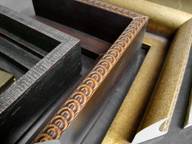 Photo 2
Photo 2
Carved antique silver (L), walnut (C), speckled antique gold curve (R).
Though selecting a frame to enhance your painting is very important, it is only one part of the consideration. Since your framer will be the one to worry about how to deal with long vs. short base frames it may seem like none of this should be any of your concern. But understanding the fitting process of your selected float frame may better explain framing costs while also assisting if you should decide to reuse the same frame on another painting of equal size.
Long Base Profiles
Long base profiles are by far the easiest to mount and give the art the most support, but it appears that short base profiles may offer more design flexibility for manufacturers and since they use less raw material they are usually lower in price than their long base counterpart. The placement of screw assembly and attachment of a panel or cradle to any L-shape frame will depend on the width of the base of the frame profile.
A thin painted panel or hardboard may be glued to a platform of wood to allow for the art to hang over and float in the frame. This is called a lifted—or platform—float mounting (photo 3). A single screw is positioned to attach through the long base directly into the bottom of the platform (lifter). It is best to glue the art directly to this removable lifter so paintings may be switched out by simply unscrewing it from the frame, cutting a new platform of equal size and depth, and screwing that back into the frame.
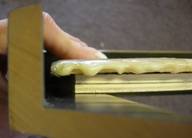
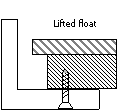
A solid float mounting would be the type used for a long base frame and cradle or thick plywood painting substrate. A substrate is the selected base material the painting is applied to whether rag board, hardboard, birch plywood, or cradled panel. Metal screws are better for assembly than wood screws because of their continuous threading all the way to the head and the flat head shape which allows for countersinking into the frame. Generally #6, ¾" flat head Phillips metal screws are the best choice.
Screw Placement
Mounting screws should be placed ¼"-½" from the inside edge of the frame base (photo 4) depending on the encaustic substrate and they should be long enough for adequate threading. If a cradle the screw should align to the center of the side wood support.
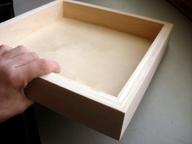
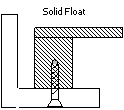
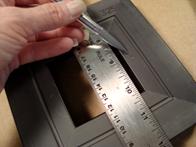 Photo 5
Photo 5
Screws are set ¼"-½" from the inner edge of the base.
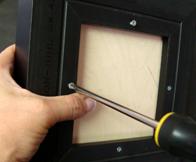 Photo 6
Photo 6
Platforms or cradles are screwed to the frame from the back.
Whatever the profile shape or substrate you use for your painting, make sure you understand what your framer is going to do and how he/she plans to adhere or hold your painting in place. Asking questions and working to help educate your framer about our medium of encaustic will help build a better working relationship between you. If you are a do-it-yourself artist/framer you can email me if you have additional questions.
END
Copyright © 2010 Chris A Paschke
For more articles on mounting basics look under the mounting section in Articles by Subject.
There is a special section in the library for all past IEA Framing Matters articles from Wax-On!
Additional information on all types of mounting is found in:
The Mounting and Laminating Handbook, Second Edition, 2002,
The Mounting And Laminating Handbook, Third Edition, 2008 and
Creative Mounting, Wrapping, And Laminating, 2000 will teach you everything you need to know about getting the most from your dry mount equipment and materials as an innovative frame designer.
All books are available from Designs Ink Publishing through this website.
Chris A Paschke, CPF GCF
Designs Ink
Designs Ink Publishing
785 Tucker Road, Suite G-183
Tehachapi, CA 93561
P 661-821-2188
chris@designsinkart.com